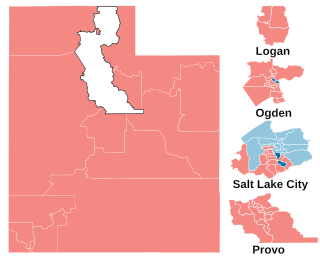Related Research Articles

The Seventeenth Amendment to the United States Constitution established the direct election of United States senators in each state. The amendment supersedes Article I, Section 3, Clauses 1 and 2 of the Constitution, under which senators were elected by state legislatures. It also alters the procedure for filling vacancies in the Senate, allowing for state legislatures to permit their governors to make temporary appointments until a special election can be held.

The flags of the U.S. states, territories, and the District of Columbia exhibit a variety of regional influences and local histories, as well as different styles and design principles. Modern U.S. state flags date from the turn of the 20th century, when states considered distinctive symbols for the 1893 World's Columbian Exposition in Chicago, Illinois. Most U.S. state flags were designed and adopted between 1893 and World War I.

The State of Deseret was a proposed state of the United States, proposed in 1849 by settlers from the Church of Jesus Christ of Latter-day Saints in Salt Lake City. The provisional state existed for slightly over two years and was never recognized by the United States government. The name derives from the word for "honeybee" in the Book of Mormon.

The flag of the State of Utah was adopted in February 2011 and consists of the seal of Utah encircled in a golden circle on a background of dark navy blue. It replaced a previous, albeit rather similar flag that had been in use since 1913. It is one of the state flags of the United States.

The Utah Supreme Court is the supreme court of the state of Utah, United States. It has final authority of interpretation of the Utah Constitution. The Utah Supreme Court is composed of five members: a chief justice, an associate chief justice, and three justices. All justices are appointed by the governor of Utah, with confirmation by the Utah Senate. The five justices elect one of their own to serve as chief justice and another to serve as associate chief justice, each for a term of four years.

The Utah State Legislature is the state legislature of the U.S. state of Utah. It is a bicameral body, comprising the Utah House of Representatives, with 75 state representatives, and the Utah Senate, with 29 state senators. There are no term limits for either chamber.

The Utah State Senate is the upper house of the Utah State Legislature, the state legislature of the U.S. state of Utah. The Utah Senate is composed of 29 elected members representing an equal number of senate districts. Each senate district is composed of approximately 95,000 people. Members of the Senate are elected to four-year terms without term limits. The Senate convenes at the Utah State Capitol in Salt Lake City.

Leonard John Nuttall Sr. was a private secretary for John Taylor and Wilford Woodruff, and was a member of the Council of Fifty who kept a detailed journal of the early history of the Church of Jesus Christ of Latter-day Saints.

The 1896–97 United States Senate elections were held on various dates in various states. As these U.S. Senate elections were prior to the ratification of the Seventeenth Amendment in 1913, senators were chosen by state legislatures. Senators were elected over a wide range of time throughout 1896 and 1897, and a seat may have been filled months late or remained vacant due to legislative deadlock. In these elections, terms were up for the senators in Class 3.

The 1898–99 United States Senate elections were held on various dates in various states. As these U.S. Senate elections were prior to the ratification of the Seventeenth Amendment in 1913, senators were chosen by state legislatures. Senators were elected over a wide range of time throughout 1898 and 1899, and a seat may have been filled months late or remained vacant due to legislative deadlock. In these elections, terms were up for the senators in Class 1.

The 1902–03 United States Senate elections were held on various dates in various states. As these U.S. Senate elections were prior to the ratification of the Seventeenth Amendment in 1913, senators were chosen by state legislatures. Senators were elected over a wide range of time throughout 1902 and 1903, and a seat may have been filled months late or remained vacant due to legislative deadlock. In these elections, terms were up for the senators in Class 3.

The Utah State Defense Force (USDF), formerly known as the Utah State Guard, is the currently unorganized state defense force of the state of Utah. The USDF, along with the Utah National Guard, is part of the organized militia of Utah. However, unlike the National Guard, the State Defense Force is by law solely under the command of the Governor of Utah and cannot be federalized or deployed outside the borders of Utah. Although inactive, Utah's State Defense Force Act allows the Governor to reactivate the USDF through executive action.

The 2018 Utah House of Representatives election was held in the U.S. state of Utah on November 6, 2018, to elect members to the House of Representatives of the 63rd Utah State Legislature. A primary election was held in several districts on June 26, 2018. The election coincided with the election for U.S. Senate and other elections.

Robert Craig Chambers was an American 19th-century businessman, minerals miner, banker, politician, sheriff, and silver mine supervisor. He had mining investments in many states, and was one of the best-known miners in the west. Chambers was a prominent figure in the formation of Butte, Montana, and Park City, Utah; and was named one of Utah's Bonanza Kings because he led the operation of the Ontario silver mine near Park City, from 1872 until 1891.
References
- ↑ John T. Caine, Biographical Directory of the United States Congress